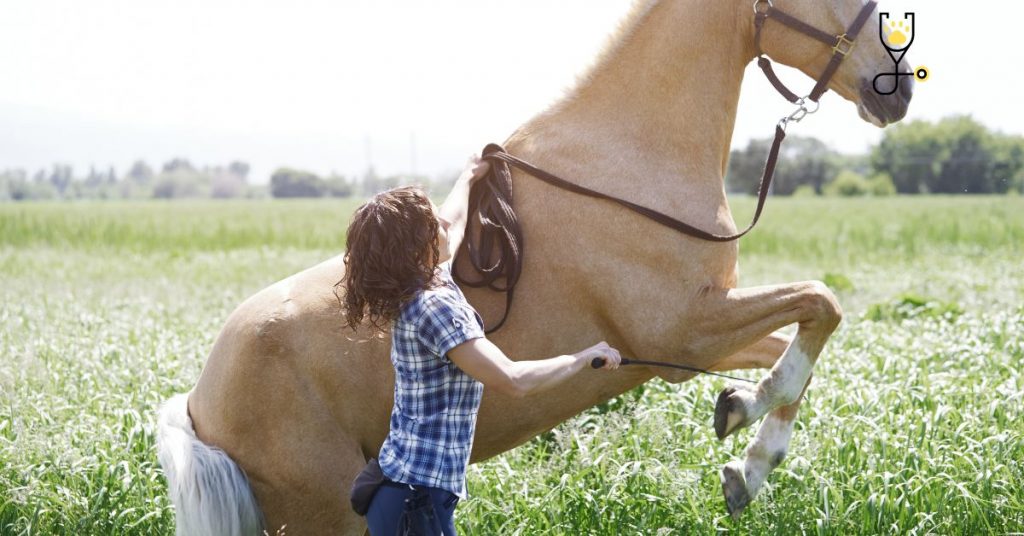Have you ever seen your horse rear? It can be a startling sight, but fortunately, it’s not usually a sign of danger. In this post, we’ll explore what rearing is, why horses do it, and how to deal with it if it happens. Stay tuned for more interesting facts about one of our favorite animals!
What Is Rearing in Horses?
Rearing is when a horse stands on its hind legs with either both or one front leg raised off the ground. It is usually done in response to fear, pain, surprise, or excitement. This can be a startling sight for those watching, but it is rarely dangerous.

9 Reasons Why Do Horses Rear?
1. Fear: Horses can rear out of fear in response to a sudden loud noise or when they’re startled by something unexpected.
2. Pain: If a horse is in pain, it may try to relieve pressure on its body by rising up on its hind legs.
3. Aggression: In rare circumstances, a horse may rear an aggressive act towards another animal or person.
4. Curiosity: Rearing can also be done out of curiosity, especially if the horse is young and still learning about boundaries and etiquette with humans and other animals.
5. Playfulness: Some horses will rear as part of playtime activities and games with other horses or people; this should always be closely monitored for safety.
6. Excitement: Horses may rear in response to strong emotions such as excitement or joy, especially during competitions and races.

7. Anxiety: Rearing can sometimes be a sign of anxiety in horses that are feeling stressed or overwhelmed by the situation they’re in.
8. Habit: If rearing has been reinforced as a positive behavior, it could become a habit for some horses.
9. Training: Finally, some trainers use rearing as part of their training techniques; however, this should only ever be done under close supervision and with proper safety equipment in place.
How To Deal With Horse Rearing?
It’s important to remember that horse rearing is not inherently dangerous and can often be addressed with the right technique. Here are a few tips for dealing with horse rearing:
1. Remain calm and patient
The first step is to remain as relaxed and calm as possible; if you panic, your horse will pick up on it and become more anxious.
2. Identify the cause
If your horse has started rearing, try to identify the cause of its behavior before attempting to address it.
3. Talk softly and move slowly
Talking in a soft, calming voice can help reassure your horse that there’s no danger present. Move slowly around the animal, so it doesn’t feel threatened or startled by your movements.
4. Use body language
Horses understand body language better than verbal commands, so using your posture and positioning to communicate can be very effective.

5. Introduce distractions
Distractions such as toys or treats can help break the cycle of rearing behavior by giving the horse something else to focus on.
6. Use a halter and lead rope
Halters and lead ropes can provide additional control and safety while working around your horse; they also allow you to steer the animal away from any potential hazards it may be reacting to.
7. Seek professional help
If the problem persists or if you’re unsure how to address it, seek help from a qualified trainer or veterinarian who specializes in equine behavior.
Rearing is usually not dangerous, but it can be uncomfortable for both horse and rider. Understanding why horses rear and knowing how to address it can help ensure a safe, enjoyable experience for all involved. Now that you know more about what rearing is, why horses do it, and how to deal with it if it happens, you have the knowledge and confidence to enjoy time spent around your horse without having to worry! Always remember that safety is paramount when working with any animal. If you ever feel unsafe or unsure of how to proceed in any given situation, always seek the advice of an experienced professional. Happy riding!
Conclusion
Rearing is a complex behavior that can have many different causes. It’s important to understand why horses rear and how to recognize the signs so you can address them safely and effectively. With patience, understanding, and the right tools, horse rearing doesn’t have to be something to fear—it can be an opportunity for learning and growth between horse and rider. So remember safety first, and happy riding!
Frequently Ask Questions
Q1: Is horse rearing dangerous?
A1: It can be, depending on the cause and situation. If a horse is rearing out of fear or anxiety, it may become more panicked and pose a danger to itself or those around it. It’s important to always remain in control and use safety equipment such as halters and lead ropes when dealing with horses that are prone to rearing.
Q2: How do I know if my horse is rearing?
A2: Horses that rear usually show signs such as lifting their front feet off the ground or lifting their head while arching their back. They may also make sounds like neighing or snorting, which can indicate they’re feeling stressed or anxious. If you see any of these behaviors, it’s important to remain calm and address the situation appropriately.
Q3: How can I prevent my horse from rearing?
A3: Regular training and exercise can help keep your horse fit and focused, reducing their stress levels and chances of rearing. Additionally, identify the cause of any rearing behavior so you can address it properly; for example, if your horse is spooked by loud noises or unfamiliar surroundings, take steps to reduce its exposure to them. Finally, always use safety equipment such as a lead rope when working with horses that are prone to rearing. Good communication between horse and rider is essential for building trust and understanding—and it’s also the key to preventing future rearing incidents.
Q4: What should I do if my horse starts to rear?
A4: – Remain calm: panic or frustration can make the situation worse.
– Speak calmly and use body language to show your horse you’re in control.
– Introduce distractions such as toys or treats to break the cycle of rearing behavior.
– Use a halter and lead rope for additional safety and control.
– Seek professional help if the problem persists. Above all, remember that safety is paramount when working with any animal—so if you ever feel unsafe or unsure of how to proceed, always seek the advice of an experienced professional.
Q5: How do I know if my horse is rearing out of fear?
A5:- Your horse may exhibit signs of fear such as ears back, eyes wide, or trembling.
– Your horse may become more agitated or animated when exposed to the triggering stimulus.
– Your horse may try to move away from the source of fear or seek comfort from you. If your horse is exhibiting any of these behaviors, it’s important to remain calm and take steps to address the underlying cause so that both you and your horse can enjoy a safe and enjoyable experience. Seeking professional help can also be beneficial in these situations.





